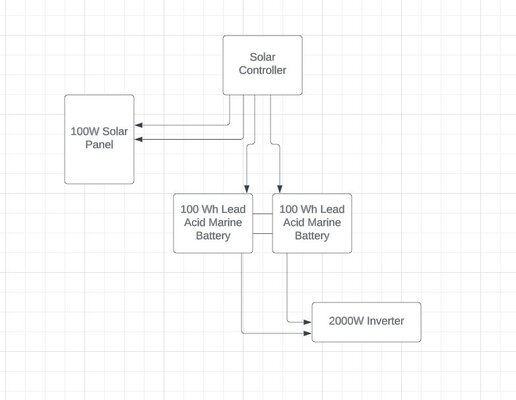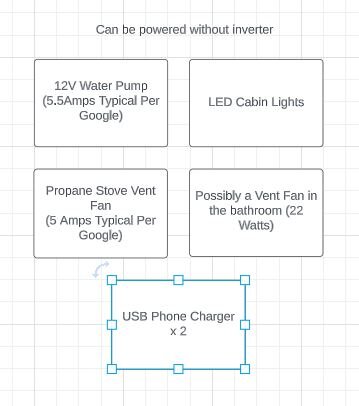Strangebird00
Member
New here to the forum but I figured this could be a good place to hopefully get some advice on hooking up the most basic of basic solar setups. I am hoping someone can look at my plans and let me know if I am looking at this the right way. My wife and I have a 16' Clipper Camper and every once in a while we go to a campground that has absolutely no electricity. I am completely illiterate when it comes to electricity in general but I have been watching tons of videos trying to wrap my brain around how to set up a simple system with my camper. We are slowly trying to buy the pieces we need to make everything work as I am learning the process.
So far I have a 100W "briefcase" panel from Harbor Freight (link below for reference) that I have had decent luck with using alongside my Jackery power station.
https://www.harborfreight.com/home/electrical/solar/100-watt-solar-panel-briefcase-57991.html. How long do you think it would take to charge 2 batteries with a 100W panel in good sunny conditions?
I have also upgraded the battery box to a double battery box with the expectation of adding a second Marine Deep Cycle Lead Acid Battery (I think that would give me 100Wh between the two batteries (50Wh each as I was told you shouldn't run them much lower than 50%)).
I am not sure how fast I could charge up these batteries with a 100W panel, but worst case, I can run a generator at the campground for 2 hours. I recently got a 2500W Peak/1850W running generator I can use if need be.
I found out that my outlets in the camper only work if the camper has power meaning they do not run off the batteries so I believe I will have to have an inverter. After learning that, I am thinking of installing a 1000-2000W Pure Sine Wave inverter. Would I also need a shutoff switch between the battery and the inverter?
I have been trying to find a good video of installing a simple system like I have in my head, but every video I have found is people wanting to run their entire camper off the inverter. We will only been needing to run a small fan, the LED lights, phone chargers, and the water pump. So I think the plan is to just plug stuff directly into the inverter if it requires a plug. One other Idea I had (if its possible) is to install a wall socket in the camper and wire it to the inverter so that I can hide the inverter under the bed and be able to use the wall outlet for anything I need to run off the batteries/inverter.
Is there some LED screen or something I could install to see the volts and wattage I am drawing from the batteries as well as what I am getting from the solar/generator or would this information be provided with the solar controller?
Here is the simple system I drew out to help it make sense in my mind. The thing I do not know about it fuses and all that. I have seen people say you need a fuse between the battery and the inverter but I do not know. I don't know what size you would need either.

If you have made it this far, Thanks for taking the time to read it. Please let me know if you guys think I am on the right track here. Also, if there are any components you can recommend, that would be fantastic. Keep in mind, I am trying to do this as simple and as cheap as humanly possible as this will only be used in the handful of times a year we go to this one particular campground.
Thanks again ahead of time for anyone that takes the time to read this and respond!
So far I have a 100W "briefcase" panel from Harbor Freight (link below for reference) that I have had decent luck with using alongside my Jackery power station.
https://www.harborfreight.com/home/electrical/solar/100-watt-solar-panel-briefcase-57991.html. How long do you think it would take to charge 2 batteries with a 100W panel in good sunny conditions?
I have also upgraded the battery box to a double battery box with the expectation of adding a second Marine Deep Cycle Lead Acid Battery (I think that would give me 100Wh between the two batteries (50Wh each as I was told you shouldn't run them much lower than 50%)).
I am not sure how fast I could charge up these batteries with a 100W panel, but worst case, I can run a generator at the campground for 2 hours. I recently got a 2500W Peak/1850W running generator I can use if need be.
I found out that my outlets in the camper only work if the camper has power meaning they do not run off the batteries so I believe I will have to have an inverter. After learning that, I am thinking of installing a 1000-2000W Pure Sine Wave inverter. Would I also need a shutoff switch between the battery and the inverter?
I have been trying to find a good video of installing a simple system like I have in my head, but every video I have found is people wanting to run their entire camper off the inverter. We will only been needing to run a small fan, the LED lights, phone chargers, and the water pump. So I think the plan is to just plug stuff directly into the inverter if it requires a plug. One other Idea I had (if its possible) is to install a wall socket in the camper and wire it to the inverter so that I can hide the inverter under the bed and be able to use the wall outlet for anything I need to run off the batteries/inverter.
Is there some LED screen or something I could install to see the volts and wattage I am drawing from the batteries as well as what I am getting from the solar/generator or would this information be provided with the solar controller?
Here is the simple system I drew out to help it make sense in my mind. The thing I do not know about it fuses and all that. I have seen people say you need a fuse between the battery and the inverter but I do not know. I don't know what size you would need either.

If you have made it this far, Thanks for taking the time to read it. Please let me know if you guys think I am on the right track here. Also, if there are any components you can recommend, that would be fantastic. Keep in mind, I am trying to do this as simple and as cheap as humanly possible as this will only be used in the handful of times a year we go to this one particular campground.
Thanks again ahead of time for anyone that takes the time to read this and respond!





